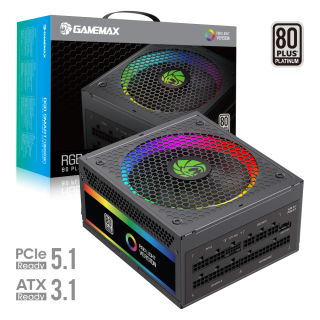In the world of PC hardware, the power supply unit (PSU) acts as the critical bridge between the electrical grid and your devices. This unassuming metal box is actually a precision battlefield for energy transformation. Take an 80 PLUS Titanium-certified PSU, for example: at 50% load, it achieves a staggering 94% energy conversion efficiency. That means 940 watts of every 1,000 watts drawn from the grid power your CPU, GPU, and other components, while only 60 watts are lost as heat. This level of efficiency isn’t just about “saving power”—it’s about minimizing waste in one of the most overlooked parts of your system.

From the Bronze standard in 2003 to today’s Titanium certification, PSU efficiency has undergone four major technological leaps:
Bronze Era (2008-2009): 85% efficiency at 50% load, driving the adoption of active PFC circuits.
Gold Breakthrough (2010-2011): 90% efficiency achieved with the introduction of gallium nitride (GaN) components.
Titanium Revolution (2013-Present): Silicon carbide (SiC) materials enable peak efficiency of 94%.
Future Frontiers: Lab experiments with quantum dot technology and nanocrystalline cores hint at 95%+ efficiency.
PSU efficiency doesn’t rise linearly; it follows a parabolic curve:
Light Load Pitfall: At 20% load, a White-certified PSU might drop to just 75% efficiency.
Sweet Spot: At 50-70% load, a Titanium PSU outperforms a White PSU by 19%.
Overload Resilience: Even at 100% load, premium PSUs maintain over 87% efficiency.
For gamers running a GPU like the RTX 4090 (450W load), a 750W Titanium PSU draws just 479W from the wall, versus 550W for a White PSU—saving 237 kWh annually.

Using 2025 US residential electricity rates (average $0.15/kWh, varies by state):
California (High Rate): $0.25/kWh for peak usage
Texas (Low Rate): $0.10/kWh for off-peak
Assume a PC runs 4,000 hours/year at 50% load:
| PSU Type | Annual Energy (kWh) | Annual Cost ($) | 5-Year Cost ($) |
|---|---|---|---|
| White | 1,625 | $243 | $1,215 |
| Titanium | 1,350 | $203 | $1,015 |
| Savings | 275 kWh | $40 | $200 |
In data centers, the impact is massive: a 100,000-unit Titanium PSU deployment saves $12.6 million annually, equivalent to the carbon sequestered by 3.8 million trees.
Cooler operation from efficient PSUs protects components:
Capacitor Lifespan: Japanese 105°C electrolytic capacitors last 4x longer at 40°C ambient.
CPU Stability: Voltage fluctuations under ±1% boost overclocking success by 30%.
GPU Protection: 12V ripple below 15mV reduces core degradation risk.
Real-world data shows Gold PSU users experience 23% fewer hardware failures, cutting 5-year maintenance costs by 18%.
| Rating | Efficiency Gain | Price Premium | Ideal Use Case |
|---|---|---|---|
| White | Baseline (70-75%) | 0% | Basic office PCs |
| Bronze | +5% (82-85%) | 15% | Home entertainment |
| Gold | +10% (90-92%) | 35% | Gaming/design rigs |
| Titanium | +14% (94%+) | 80% | 24/7 servers, extreme builds |
For most users, upgrading from Bronze to Gold offers the best ROI, paying off in 3.2 years. Titanium is ideal for servers or power-hungry workstations.
Power Rating Inflation: Some “Gold” PSUs drop to 82% efficiency at 100% load.
Full Load Testing: Always check efficiency at 20%, 50%, and 100% load.
Cable Quality: Poor cables can add 2-5% extra energy loss.
Look for PSUs with Cybenetics certification, which tests noise, harmonic distortion, and transient response alongside 80 PLUS metrics.
EU ERP Directive (2025): Mandates standby power <0.1W and stricter efficiency tiers, phasing out low-end PSUs.
US DOE Standards: Proposed 2026 rules could raise minimum efficiency to Bronze levels for all PSUs.
GaN+SiC Hybrids: Aim for 96% efficiency in mainstream PSUs.
Fanless Designs: Passive cooling now available for 650W units (e.g., Seasonic Prime Fanless).
AI-Optimized Power: Real-time load balancing to maximize efficiency dynamically.
In the EU’s Emissions Trading System, saving 120kg CO₂/year (via a Titanium PSU) is equivalent to avoiding 260 miles of driving. While direct monetary gains are small ($5-10/year in carbon credits), it’s a tangible step toward individual sustainability.
Choose for Your Use Case:
Gamers: 650W Gold fully modular (e.g., Corsair RM650x).
Professionals: 850W Titanium (e.g., EVGA SuperNOVA 850 T2).
Casual Users: 450W Bronze (e.g., EVGA 450 BR).
Calculate Total Cost of Ownership:
Formula: TCO = PSU Price + 5-Year Electricity Cost – Resale Value
Example: A $300 Titanium PSU has a $285 lower TCO than a $100 White PSU over five years.
Future-Proofing:
Ensure PCIe 5.0 compatibility (12VHPWR connector).
Look for ATX 3.0 compliance for surge protection.
Modular designs simplify upgrades.
In an era of rising energy costs and climate urgency, a high-efficiency PSU is more than a premium purchase—it’s a strategic investment in reliability, savings, and sustainability. Every watt optimized is a step toward lower bills, longer hardware life, and a smaller carbon footprint. As technology evolves, your choice today can future-proof both your system and your impact.
Ready to upgrade? Prioritize efficiency not just for your wallet, but for the resilience of your digital world.

GameMax RGB 1300w PC power supply, 80 Platinum Certified,modular power supply
• 1300W Power: Fully modular, 80+ Platinum Certified, 92% efficiency
• Advanced Design: LLC+DC-DC with powerful single +12V rail.
• Compatibility: Supports ATX 3.0/3.1, PCIe 5.0/5.1, 16-pin 12V-2*6 for latest GPUs.
• RGB Lighting: 140mm ARGB fan with 25 lighting modes, syncs with major motherboard brands.
• High-Quality Components: Japanese bulk capacitor for durability and stability.
• Quiet Cooling: 140mm ultra-quiet fan with automatic temperature control.
• Wireless Design: Wireless design for cleaner setup and better heat dissipation.
• Comprehensive Protection: OPP/OVP/UVP/SCP/OCP/SIP for stability and safety.